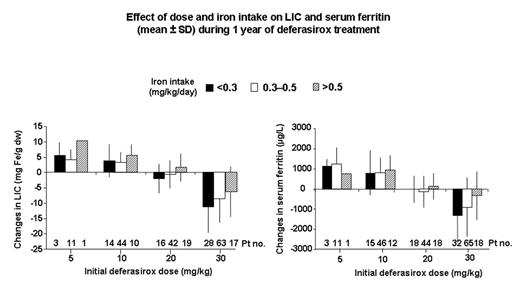Abstract
The clinical benefits of chelation therapy for treating iron overload are well established. In a large randomized Phase III study conducted in 586 iron overloaded patients with β-thalassemia to assess once daily oral therapy with deferasirox versus subcutaneous deferoxamine (DFO), we previously showed that deferasirox led to a statistically significant reduction of iron burden in patients whose baseline LIC was ≥ 7 mg Fe/g dw and that this change was similar to that observed with DFO. We have subsequently analyzed the role of transfusional iron intake in influencing individual responses. In this study, transfusion data were collected among 296 patients receiving deferasirox and 290 patients receiving DFO. If volumes (in mL RBC) were provided for the transfusions, iron intake (in mg) was calculated by multiplying the mL RBC by 1.08. If transfusion was reported as number of units, each unit was assumed to contain 185 mL RBC or 200 mg iron. For each patient, the cumulative transfusion amounts during the study were recorded, and the total iron intake was calculated as mg/kg/day using the patients’ body weight and their time on study.
The average iron intake rate during the study was 0.38 mg/kg/day which corresponds to approximately 0.35 mL/kg/day. The 25–75th percentiles included 0.30 to 0.47 mg/kg/day. Among patients receiving deferasirox, 70 (23.6%), 174 (58.8%) and 52 (17.6%) had a transfusional iron intake rate of <0.3, 0.3–0.5 and >0.5 mg/kg/day, respectively. Patients in the lowest transfusional iron loading group (<0.3 mg/kg/day) had an average rate of iron intake of 0.25 mg/kg/day, whereas patients in the higher iron intake groups of 0.3–0.5 and >0.5 mg/kg/day had an average intake rate of 0.39 and 0.55 mg/kg/day, respectively. The iron intake in mg/kg/day was higher in young children compared to adolescents and adults (0.48 for <6 years, 0.43 for 6–<12 years, 0.37 for 12–<16 years, 0.35 for ≥ 16 years). Iron intake rate affected the change in LIC and serum ferritin in response to chelation therapy. In the 30 mg/kg deferasirox cohort, the greatest decreases in LIC and ferritin levels were observed in patients with the lowest iron intake (Figure). Similar results were found in the group receiving DFO. In the 10 mg/kg deferasirox cohort, the LIC decreased in 10/58 (17%) of the patients in the <0.5 mg/kg/day group but in none of the patients in the iron intake >0.5 mg/kg/day group.
Effect of dose and iron intake on LIC and serum ferritin (mean ± SD) during 1 year of deferasirox treatment
Effect of dose and iron intake on LIC and serum ferritin (mean ± SD) during 1 year of deferasirox treatment
In conclusion, the rate of transfusional iron loading has an important effect on the outcome of chelation therapy, and dosing should be individualized based on the transfusional iron intake, the severity of iron overload and the treatment goal of maintenance or reduction of body iron.
Author notes
Corresponding author


